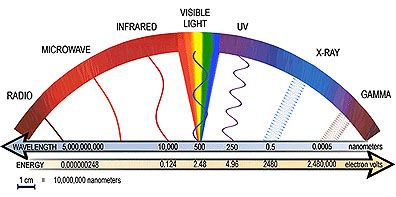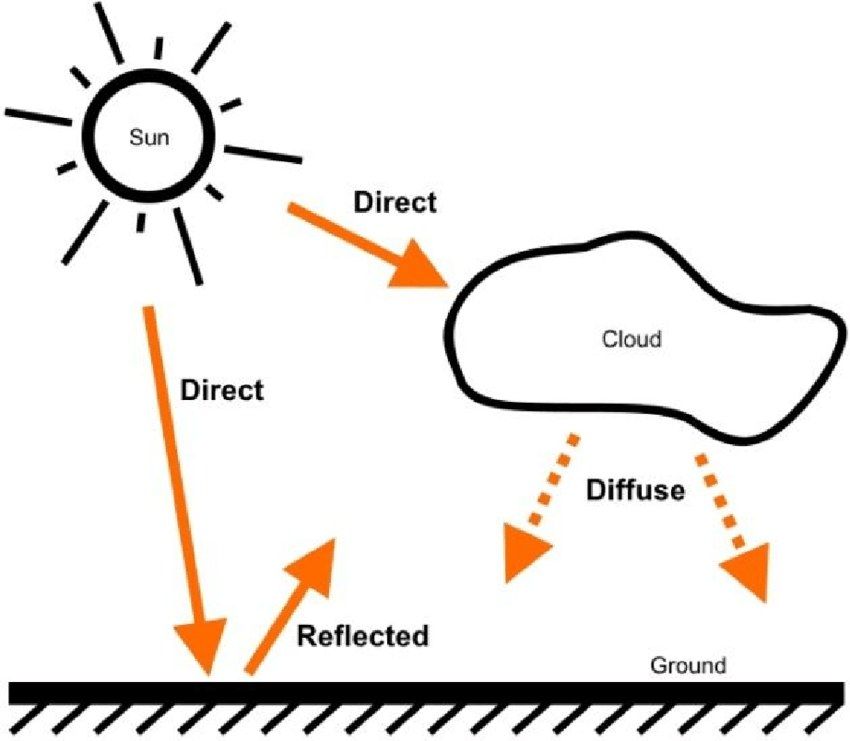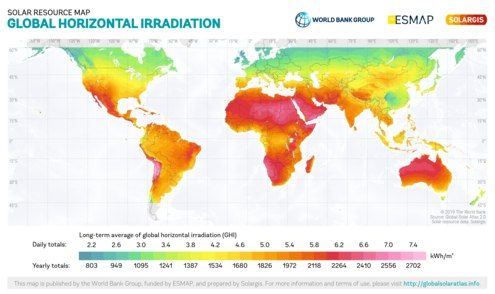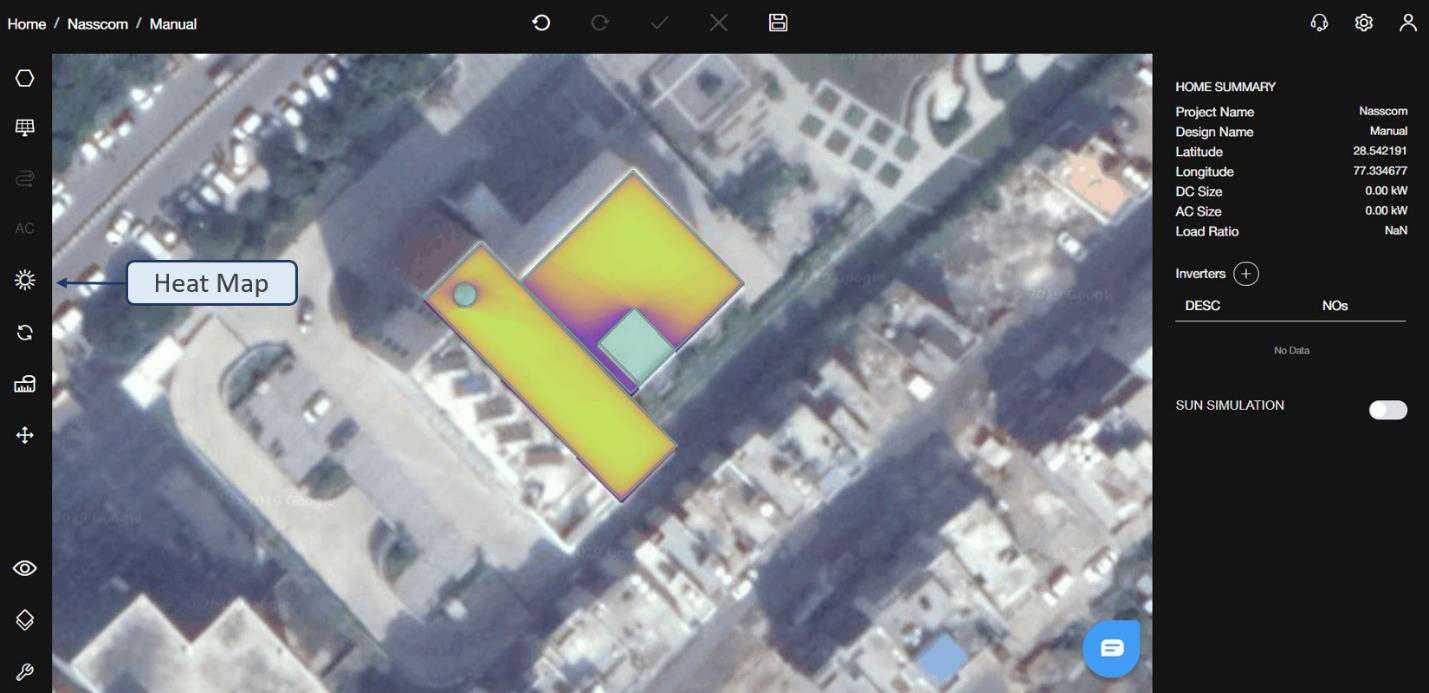Solar Irradiance Calculation Guide

How much sunlight do I receive?: A guide to calculating solar irradiance
The term “Photovoltaic” is a portmanteau of two words - “photo”, the Greek word for light and “voltaic” which means voltage. Therefore, a photovoltaic system operates on “light” inputs and converts it into current or voltage. The mechanism behind this conversion is based on semiconductor junctions.
Thus, one can deduce that such a system is heavily dependent on the quantity of input i.e. sunlight it receives. This is known as solar irradiance that is, the power per unit area received from the sun in the form of light.
When you begin designing your solar plant, either for yourself or a customer, solar irradiation is probably one of the first things you calculate. This can be accomplished by using a series of formulae and solar angles or it can be automated with solar designing software. The advantage of using design software is that it can determine insolation remotely; it does not rely on manual measurements at the site location. With the click of a button, it can generate a map indicating the solar irradiance at each point of your site.
Our team of engineers at ARKA 360 has combined all the steps involved in determining a location’s solar irradiation. The Design Studio is a powerful tool that allows you to take advantage of automated software to find accurate answers to your radiation questions. This post explores the types of solar irradiance and how you can gauge it for yourself.
What is solar irradiance?
The nearly perfect sphere of hot plasma at the center of the solar system, that is, the sun, emits energy in two forms; heat and light. Photovoltaic systems are concerned only with the “light” component of this radiation. Light energy is a form of electromagnetic radiation (waves of electric and magnetic fields). The spectrum of electromagnetic radiation that Earth receives from the sun includes visible light, ultraviolet light, infrared, radio waves, X-rays and gamma rays. This is also known as solar radiation.Fig. 1. Spectrum of electromagnetic radiation
The sun generates about 3.8e+33 ergs per second (3.8e+26 W) of power. However, Earth is able to capture only a fraction of this energy; an average of 1.4 kilowatts per square meter. A number of factors control the amount of radiation we receive. These include geography, time of day, season, local landscape, and local weather.
Solar irradiance is the intensity of the radiation Earth receives. A simple way to understand this is to compare a 20-watt lightbulb with a 100-watt light bulb. Both light bulbs produce visible light in the same wavelengths. However, the intensity and brightness are vastly different. The 100-watt bulb has higher intensity or irradiance. Solar irradiance is the amount of light energy we receive per unit area. It is measured in watts per square meter (W/m2).
Types of irradiation
There are various types of measured radiation.

Fig. 2. Types of solar radiation
Total Solar Irradiance (TSI)
Measured perpendicular to incoming sunlight, the Total Solar Irradiation is the cumulative solar power over all wavelengths that is incident on the Earth’s upper atmosphere, per unit area.
Direct Normal Irradiance (DNI)
Also known as direct or beam radiation, Direct Normal Irradiance is the amount of solar power measured at the Earth’s surface on a plane perpendicular to the sun’s rays. It does not include diffuse solar radiation (radiation that is scattered or reflected by atmospheric components). It is equal to the extraterrestrial irradiance above the atmosphere minus the atmospheric losses due to absorption and scattering.
Diffuse Horizontal Irradiance (DHI)
Diffuse Horizontal Irradiance or Diffuse Sky Radiation is the radiation received by the Earth’s surface from light scattered by the atmosphere. There would be almost no DHI without an atmosphere.
Global Horizontal Irradiance (GHI)
GHI is the total irradiance from the sun that is received by a horizontal surface on Earth. It is the sum of Direct Irradiance and Diffuse Horizontal Irradiance.
GHI = DHI + DNI x cos (solar zenith angle)

Fig 3. Global map of Global Horizontal Irradiation
Of all these values of irradiance, determining whether or not direct beams from the sun can reach the solar array requires the most processing power. The amount of direct radiation incident on a panel is contingent on the shade caused by obstacles around the panel.
Determining irradiance for your site
To better understand this calculation, let us consider a site in San Francisco, California, USA. It has the following coordinates: 37.7749° N, 122.4194° W. It follows Pacific Standard Time i.e. GMT-8.
Solar time
Local time is the time that you see on your local clocks and watches. It is the time at a specific location or meridian. Each location has a time zone in reference to the prime meridian which is located at 0° longitude. This is known as Coordinated Universal Time (UTC). For example, if the local time is four hours behind UTC, the local time zone is UTC-4.
Solar time is different from local time. It is a calculation of the passage of time based on the position of the sun in the sky relative to one specific location on the ground. The fundamental unit of solar time is day. Solar noon is when the sun is at its highest point during the day - when it is at true south in the sky. Solar time can be calculated using the formulae available here.
For 15 June, that is, the 166th day of the year in San Francisco, California, at 1 p.m (1300 hours), the solar time is 11:50 a.m. On this day, solar noon occurs at 1:09 p.m local time.
Solar Angles
Fig. 4. Altitude and azimuth solar angles
The shadow cast by an obstacle depends on the relative position of the sun in the sky, that is sun or solar angles. The shadow changes shape and location as the sun moves throughout the day. Moreover, the sun follows a different path each day of the year. Therefore, irradiance changes every hour of every day. For the given time in San Francisco, the solar angles are determined to be as follows:
Solar declination: 23.31°
Solar Altitude: 75.38°
Solar Azimuth angle: 9.06° East
Solar Hour angle: 2.48°
Air mass ratio: 1.033
These values can be determined for any location using this calculator. Our post on solar angles can help you understand the significance of these angles.
Total Insolation
Your panel has two associated angles as well; azimuth and tilt. Similar to solar azimuth, the panel azimuth angle is it +/- angle relative to true south. Panel tilt angle or elevation angle is the vertical angle your panels make with the horizontal.
The southern direction on your compass is not true south; it is the magnetic south. The difference between magnetic north reading on your compass and true north is known as magnetic declination. This is a measure of the number of degrees you need to compensate from your compass reading to find true north. To determine the optimal collector azimuth angle, first find your magnetic declination using charts or calculators available online. For the northern hemisphere, if your declination is east (positive), rotate your panels east. If the magnetic declination is west (negative), rotate your panels west. The wrong azimuth angle can reduce the output of a PV array by 35%.
For San Francisco, the optimal azimuth angle is 13.21°. The next step is to determine the optimal tilt angle. We have two choices with regards to tilt; pick one value and leave it unchanged throughout the year or to adjust the tilt angle to optimize for seasonal production, that is, use single or dual trackers. For our convenience, we shall opt for a fixed elevation angle. To optimize overall annual production, tilt your panels at your latitude, that is, 38° in our case. Assuming reflection from common ground/grass, the clear sky beam radiation at 1 p.m is 879.986 W/m2. For a fixed, tilted solar collector the components of radiation are as follows:
Beam insolation: 807.35 W/m2
Diffuse radiation: 103.28 W/m2
Reflected radiation: 20.50 W/m2
Therefore, the total insolation on the collector surface sums up to 931.13 W/m2. Assuming that insolation remains constant throughout the hour, by adding the insolation for each hour of the day, the total daily insolation can be calculated.
Sun Path
Now that the location and solar angles at a given time of day have been determined, the position of the sun at other times can also be found out. Using the same method as above, the sunrise and sunset times can also be calculated. Thus, the total day duration, that is, the number of hours that the sun is available can be calculated. For our example, San Francisco experiences 14.77 hours of sunlight on 15 June.
Fig. 5. Position of the sun in San Francisco, California on June 15
Additionally, by plotting solar time, insolation, azimuth angle and solar altitude the position of the sun throughout the day can be tracked. The sun’s path for our example can be seen in Figure 5. A detailed report on calculating insolation for rooftop systems can be found here.
How shade affects irradiation
As outlined in our article on shade losses in PV systems, shade blocks light and can be disastrous for PV systems. Shade effectively reduces the amount of irradiance incident on a panel. Shade causes mismatch between the operating conditions of neighboring cells or modules. Shadow on even a single panel in your array can compromise the output of the entire system. In the book Renewable Energy and Efficient Electric Power Systems, Gil Masters demonstrates how shading on even a single cell in a 36 cell module can reduce power output by over 75%.
Designing a plant for your site is no easy task. Calculating irradiation is just the first step. To determine the effective amount of solar power that your site actually receives, it is necessary to take into account shade causing obstacles and to determine how they affect insolation.
Most locations receive more than 5,000 hours of sunlight per year. This means that for each point on your installation site over 5,000 potential sun positions need to be simulated. Such a complex project involves very long and lengthy calculations with multiple parameters. ARKA 360 team has developed a simple, easy-to-use tool that automates this entire process for you.

Fig. 6. Heat map showing radiation at the site
By employing Graphics Processing Units (GPUs), thousands of heavy and complex calculations can be performed parallelly, significantly speeding up operations. The tool generates a heat map, as seen in Figure 6. On the map you can locate areas of high and moderate solar potential (yellow and orange, respectively) and areas of high shade (purple). To put this in context, for a site spanning 1000 sq. metres and no shading, our software can create a heat map in 16.85 seconds.
The ARKA 360 advanced remote solar design software has made it considerably easier for designers and contractors to determine the amount of solar energy available on solar arrays. By removing the need for manual inspections and site visits, you can save almost 55% of your customer acquisition costs.

